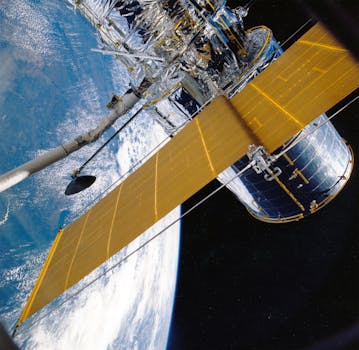From Geostationary to Low Earth Orbit: The Evolution of Satellite Telecommunications in 2023
The satellite telecommunications industry has undergone significant changes in recent years, with a shift from geostationary to low Earth orbit. This article explores the evolution of satellite telecommunications in 2023, including the benefits and challenges of low Earth orbit and the impact on the industry.

From Geostationary to Low Earth Orbit: The Evolution of Satellite Telecommunications in 2023
The satellite telecommunications industry has undergone significant changes in recent years, with a shift from geostationary to low Earth orbit. This shift has been driven by advances in technology, changes in consumer demand, and the need for more efficient and cost-effective solutions. In this article, we will explore the evolution of satellite telecommunications in 2023, including the benefits and challenges of low Earth orbit and the impact on the industry.
Historically, satellite telecommunications have relied on geostationary orbit, which is approximately 36,000 kilometers above the equator. Geostationary satellites have been used for a variety of applications, including television broadcasting, telecommunications, and weather forecasting. However, geostationary satellites have several limitations, including high latency, limited bandwidth, and high operating costs. In recent years, there has been a shift towards low Earth orbit, which is approximately 160-2,000 kilometers above the Earth’s surface. Low Earth orbit satellites have several advantages over geostationary satellites, including lower latency, higher bandwidth, and lower operating costs.
One of the main benefits of low Earth orbit satellites is lower latency. Latency refers to the time it takes for a signal to travel from the Earth to the satellite and back again. Geostationary satellites have a latency of around 250-300 milliseconds, which can be significant for applications that require real-time communication, such as video conferencing and online gaming. Low Earth orbit satellites, on the other hand, have a latency of around 20-30 milliseconds, which is much faster and more suitable for real-time applications. Another benefit of low Earth orbit satellites is higher bandwidth. Bandwidth refers to the amount of data that can be transmitted over a given period of time. Low Earth orbit satellites have much higher bandwidth than geostationary satellites, which makes them more suitable for applications that require high-speed data transfer, such as video streaming and cloud computing.
In addition to the benefits of lower latency and higher bandwidth, low Earth orbit satellites also have lower operating costs. Launching a satellite into low Earth orbit is much cheaper than launching a satellite into geostationary orbit. Additionally, low Earth orbit satellites require less power to operate, which reduces the cost of fuel and extends the lifespan of the satellite. However, low Earth orbit satellites also have some challenges, including the need for more satellites to cover the same area as a geostationary satellite and the risk of interference from other satellites and ground-based systems.
Despite the challenges, the shift towards low Earth orbit satellites is expected to continue in the coming years. Several companies, including SpaceX, OneWeb, and Amazon, are already launching constellations of low Earth orbit satellites to provide global internet coverage. These constellations will consist of thousands of satellites, which will work together to provide high-speed internet access to remote and underserved communities around the world. The impact of low Earth orbit satellites on the satellite telecommunications industry will be significant, with new opportunities for growth and innovation emerging in areas such as satellite manufacturing, launch services, and ground equipment.
In conclusion, the evolution of satellite telecommunications in 2023 is a significant shift towards low Earth orbit. The benefits of lower latency, higher bandwidth, and lower operating costs make low Earth orbit satellites an attractive option for a variety of applications, including telecommunications, navigation, and remote sensing. While there are challenges to be addressed, the potential of low Earth orbit satellites to transform the satellite telecommunications industry is vast and exciting.
The future of satellite telecommunications is likely to be shaped by several trends, including the increasing demand for high-speed internet access, the growing importance of IoT, and the need for more efficient and cost-effective solutions. As the industry continues to evolve, we can expect to see new technologies and innovations emerge, such as the development of new satellite constellations, the use of advanced materials and manufacturing techniques, and the integration of satellite and terrestrial networks.
Another trend that is likely to shape the future of satellite telecommunications is the increasing importance of sustainability. As concerns about climate change and environmental sustainability continue to grow, the satellite industry will need to adapt to reduce its environmental impact. This could involve the development of more fuel-efficient launch systems, the use of renewable energy sources, and the implementation of sustainable manufacturing practices. By embracing sustainability, the satellite industry can reduce its environmental footprint and contribute to a more sustainable future.
In the context of the satellite telecommunications industry, sustainability is not just about reducing environmental impact, but also about ensuring that the benefits of satellite technology are available to all. This includes providing access to high-speed internet and other satellite-based services to remote and underserved communities, as well as promoting digital inclusion and reducing the digital divide. By prioritizing sustainability and digital inclusion, the satellite industry can create a more equitable and connected world, where everyone has access to the opportunities and benefits of satellite technology.





